

Chromodoris obsoleta
(Rüppell & Leuckart, 1830 or 31)
Order: NUDIBRANCHIA
Suborder: DORIDINA
Superfamily: EUDORIDOIDEA
Family: Chromodorididae
DISTRIBUTION
Known only from northern Indian Ocean [Red Sea, Persian Gulf]
PHOTO
Upper: Doha, Qatar, Persian Gulf, February 1979. Photo: Tony Reavill. Lower: Suakin, Sudan, Red Sea, 25 April 1980, 17 mm long alive. AM C131569. PHOTO: Chris Todd.
Originally described from the Red Sea, there are few records of this species. The original account describes it as milky white, with an orange-brown reticulation on the mantle, and a band of orange at the mantle edge, and a submarginal band of blue-black. To that description we can ass that the rhinophores and gills are translucent brown with the edges of the leaflets outlined in opaque white. The mantle colours show through ventrally, and the foot is white. The original illustration available to me suggests a brownish background colour but this does not accord to the written text and is possibly an artistic error or a result of the deterioration of the colour plate in the 170 years since its printing.
Eliot (1911) describes the external colour and radular morphology of specimens from the Red Sea but misidentifies it as a possible form of Chromodoris reticulata Pease [see Rudman, 1973]. Gohar & Soliman (1967) describe the embryology and life history of a species they identify with C. obsoleta but from their color description of the living animal it would seem that their animal species was a species of Glossodoris and not C. obsoleta. Yonow (1989) records this species from Seghala Is, Saudi Arabia, Red Sea.
See separate message for description of the radula [#12734].
References:
• Eliot, C.N.E. (1911) Chromodorids from the Red Sea, collected and figured by Mr. Cyril Crossland. Proceedings of the Zoological Society of London, 2: 1068-1072. (Pl.61)
• Gohar, H.A.F. & Soliman, G.N. (1967) The direct development of the nudibranch Casella obsoleta (Rupp. and Leuck.) (with remarks on the metamorphosis). Publications of the Marine Biological Station, Al-Ghardaqa, Egypt, 14: 149-166.
• Rudman, W.B. (1973) Chromodorid opisthobranch Mollusca from the Indo-West Pacific. Zoological Journal of the Linnean Society, 52(3): 175-199, 7figs, 2col.pl.
• Rüppell, E. & Leuckart, F.S. (1830 or 31) Neue wirbellose Thiere des Rothen Meeres. Atlas zu der Reise im nördlichen Afrika von Eduard Rüppell. Brunner, Frankfurt am Main. 23-50, pls 7-12 pages.
• Yonow, N .(1989) Red Sea Opisthobranchia 2: The family Chromodorididae (Mollusca, Nudibranchia). Fauna of Saudi Arabia 10: 290-309.
Rudman, W.B., 2004 (August 3) Chromodoris obsoleta (Rüppell & Leuckart, 1830 or 31) . [In] Sea Slug Forum. Australian Museum, Sydney. Available from http://www.seaslugforum.net/find/chroobso
Related messages
Re: Chromodoris obsoleta & C. annulata from Abu-Dhabi, UAE
July 29, 2008
From: Yahia Mokhtar
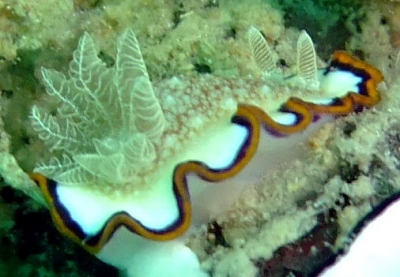
Concerning message #21728:
In my previous message, I described how I had photographed two Chromodoris annulata, then discovered while reviewing the photos at home that I had inadvertently photographed a Chromodoris obsoleta lying between them.
Yesterday I was lucky enough to meet again two or three C. obsoleta lying in between two C. annulata on another wreck in the Arabian Sea about 30 nm away from the earlier wreck, and again they were found in between two C. annulata.
Locality: MV-Hannan Wreck, 12m, Abu-Dhabi, United Arab Emirates, Persian Gulf (South), 26 July 2008, wreck on 20 m depth. Length: 25 mm. Photographer: Yahia Mokhtar.
Just wanted to share the new photos and ask about three points that I noticed:
1- Both Chromodoris obsoleta were lying in between two Chromodoris annulata.
2 - Both occurrences were on a metal wreck (not a reef).
3 - Water temperature between 33-35°C
Could this be a co-incidence?
yahia@adma.ae
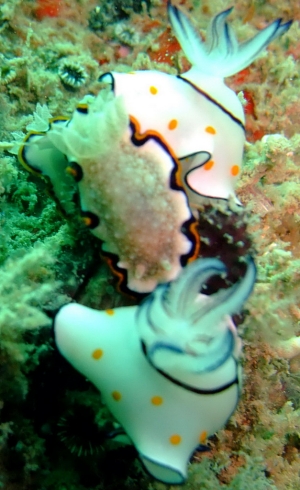
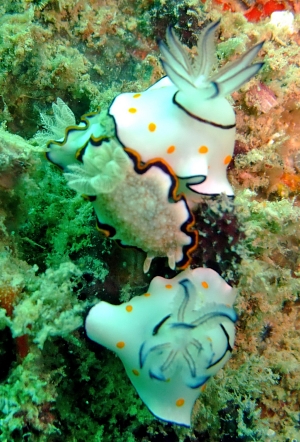
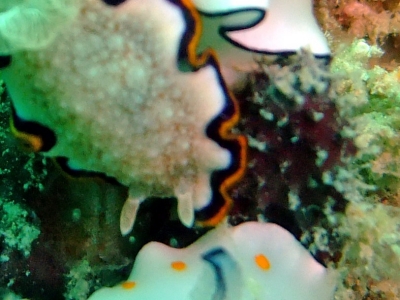
Dear Yahia,
This is a valuable find. In my comments on your earlier message I said that when I see a cluster of nudibranchs like this, either a single species or a mix of species, my first thought is "what are they eating?". In these photos we can clearly see that they are very interested in the dark purple-brown sponge on which they are sitting. I am pretty sure this sponge is the aplysillid Chelonaplysilla violacea, or at least a close relative. If you could check your photos to see if you have one that shows the surface of the sponge more clearly I would be very grateful.
As we don't know at present the food of either of these chromodorids this is a valuable clue. One piece of evidence supporting my idea that this is Chelonaplysilla violacea is that C. annulata is one of 8 species which has a large purple patch on the underside of its anterior mantle [see #20849], and of the 6 species in that group whose food choice we know, all eat Chelonaplysilla. Another clue is that in an earlier message on C. obsoleta [message #20777] the photos show it crawling on a dark purple black sponge which I suspect is also Chelonaplysilla.
In answer to your questions. The reason the species are together is their mutual attraction to the same sponge food - I am sure there is not some weird inter-species love fest going on. In another message [#12729] we have a large aggregation of C. obsoleta and one C. cazae, which would suggest that C. cazae also eats the same sponge. I also guess that there is no great significance with the C. obsoleta being between the C. annulata. I guess since the latter are much bigger animals, the C. obsoleta had to squeeze in between.
Concerning the metal wreck - if there is a relationship then it will be between the sponge and the metal. The nudibranch's relationship is directly to the sponge. However working out such relationships can be very complicated, and may be simply that you dive more wrecks than natural reefs, or that certain sponges are able to grow into larger, or at least more visible, colonies on wrecks.
Thanks for this interesting observation. If by chance you have a photo which shows more detail of the sponge's surface I would love to see it. Otherwise, if you see these chromodorids again and can take a close-up of the sponge it might help me confirm the identity of the sponge, which would mean we could add 3 more chromodorids to the list of those whose food we know.
Best wishes,
Bill Rudman
Rudman, W.B., 2008 (Jul 29). Comment on Re: Chromodoris obsoleta & C. annulata from Abu-Dhabi, UAE by Yahia Mokhtar. [Message in] Sea Slug Forum. Australian Museum, Sydney. Available from http://www.seaslugforum.net/find/21749Chromodoris obsoleta & C. annulata from Abu-Dhabi, UAE
July 24, 2008
From: Yahia Mokhtar
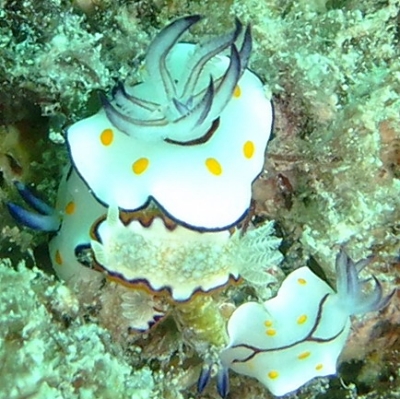
Concerning message #20841:
While diving on a wreck, I took a picture of a pair of Chromodoris annulata, but when I returned home, I was surprised to discovered a third nudibranch in between. I think this is a Chromodoris obsoleta as the magnified picture would suggest.
Locality: Old Cement Barge, Wreck, 7-10m, Abu-Dhabi, United Arab Emirates, Persian Gulf (South), 12 Jul 2008, wreck. Length: 1-2 cm. Photographer: Yahia Mokhtar.
Yahia
yahia@adma.ae
Mokhtar, Y., 2008 (Jul 24) Chromodoris obsoleta & C. annulata from Abu-Dhabi, UAE. [Message in] Sea Slug Forum. Australian Museum, Sydney. Available from http://www.seaslugforum.net/find/21728
Dear Yahia,
Thanks for this tantalising photo. It's amazing what we find in photos which we didn't see through the view finder. As I mentioned in the message you refer to, we have still a lot to learn about the biology of these animals. I suspect that when we find a group together like this, they have been attracted to their food sponge. But unfortunately, if there is a sponge present, it is overgrown with algae and we can't see it. It reminds me of an earlier message [#12729 ] showing a large cluster of C. obsoleta and one Chromodoris cazae, but no sponge visible. At present we don't know which sponges C. obsoleta, C. cazae or C. annulata feed on. Hopefully you will get lucky and find one or more of them on a sponge which can be photographed.
I see that at least the smaller C. annulata has the purple line linking the two purple circles, which is a pattern apparently unique to animals from your part of the world.
Best wishes,
Bill Rudman
Chromodoris obsoleta from Saudi Arabia
October 9, 2007
From: George Morgan

Dear Bill,
Thank you for all your help in the identification of our little friend, Chromodoris obsoleta.
We have several other photographs of them, one which shows two creatures with what looks like a 'ribbon' behind them. At the time that we took this pic we did not know what to look for but on closer inspection there appears to be a ribbon behind the one on the right.
Locality: Half Moon Bay,Eastern Province, 6-7 metres, Saudi Arabia, Persian Gulf, June 2007, silty sand. Length: 10-15 mm. Photographer: George Morgan.
Do you have any information as to when they breed? or what their preferred temperature is?
Best Regards
George Morgan
Lecturer
K.F.U.P.M.
georgehp883@yahoo.com



Dear George,
Thanks for this extra information on C. obsoleta. I'm afraid I can't help with any more information than is recorded on the Forum. We know very little about the marine biology of the northwestern Indian Ocean, and this species seems to be endemic to that area. As I mention on the species Fact Sheet, Gohar & Soliman (1967) describe the embryology and life history of a species they identify with C. obsoleta but from their colour description of the living animal it would seem that their animal was a species of Glossodoris, possibly G. hikuerensis.
Your upper two photos show sponges but it is most unlikely that they are the food of this species as I think they are both species of Euryspongia, a genus of dysideid sponges not usually eaten by chromodorids. In the top photo there is a pale purple colony in the bottom right corner; and in the middle photos the animal is crawling on a whitish network, which is the fibrous skeleton of a dead colony. Your mention of fairly extreme temperature and salinity conditions suggest they may have been the cause of the death of this colony. The animals in the bottom photo are indeed mating, but if the 'tail' you mention is the yellow object, it is a small colony of a calcareous sponge. As with the other sponges, it is most unlikely that it is a food item for this species.
If this species is reasonably common there is a good chance you will find it laying an egg ribbon, or perhaps feeding or congregating on a sponge. We have another message [#12729] showing numbers of animals congregating - and presumably feeding - on a sponge colony, but unfortunately there is not enough detail in the photo to identify the sponge.
Best wishes,
Bill Rudman
Chromodoris obsoleta from Saudi Arabia
September 27, 2007
From: George Morgan
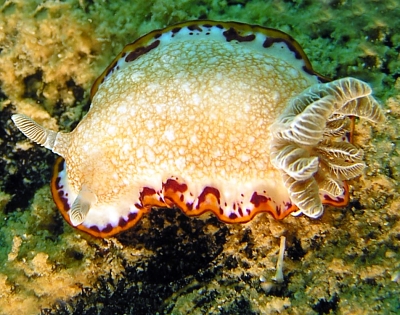
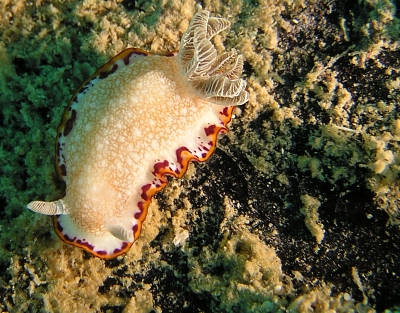
Dear Sir/ Madam,
I live in the Eastern Province of Saudi Arabia, on the southern coast of the Persian Gulf. In a small local bay called Half Moon Bay I have found numerous small off-white nudibranchs. They look very like the Chromodoris lekker, although I cannot be sure.I have enclosed some photographs and wonder if you can help me positively identify them. The problem I am having at the moment is that althought they appear similarly coloured, our specimens do not have a particularly spikey texture and all the references I have seen appear to show small but pointed spike on their skin. Any thoughts would be greatly appreciated.
Locality: Half Moon Bay, Al-Khobar, 6-7 metres, Saudi Arabia, Persian Gulf, June August, Sept 2007, sand and silt. Length: 10-15 mm . Photographer: george Morgan.
We see these creatures regularly every week and I have never seen any with definite spikes on any of them, so that would appear to rule out the possibility that they may be juvenile, as I would not have thought that they were all juveniles.
Thank you for your help.
Best Regards
George Morgan.
georgehp883@yahoo.com
Morgan, G., 2007 (Sep 27) Chromodoris obsoleta from Saudi Arabia. [Message in] Sea Slug Forum. Australian Museum, Sydney. Available from http://www.seaslugforum.net/find/20777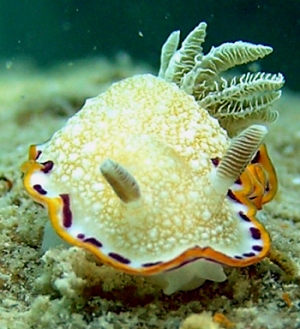
Dear George,
This is an interesting find. They do look quite like C. lekker, but the gills are 'bushier' and branched, and have a white line along the edges, while in C. lekker the gills are much simpler with a white band up the inner core of each gill. Also the rhinophores are edged in white while in C. lekker the individual leaflets on each rhinophore are smaller and are not lined with white.
Your animal is Chromodoris obsoleta which seems to be restricted to the northwestern corner of the Indian Ocean. In your photo the dark purplish black reminds me very much of a sponge of similar colour. If this species is quite common it woud be nice to confir what this species eats so if you could possibly take a close-up photo of the sponge would be grateful. As you will see from other comments of mine I am very keen to know what what these animals 'do' so if you by change see one laying an egg ribbon a photo would be very welcome.
Also, we know very little about nudibranchs in this part of the world so photos of your finds would also be welcome. It would also be valuable to check the off-white chromodorids you find because it is possible that your have more than one species present. I can't really say how one species differs on colour from another, because in many cases two or three species may look very similar to each other, so I guess the best advice I can give you is to look out for differences, Even if you send me photos of three animals which look different to you but are the same species, it doesn't really matter as it will give us a better idea of colour variation in the species.
Best wishes,
Bill Rudman
Chromodoris obsoleta from Bahrain
December 16, 2005
From: Mike Arora
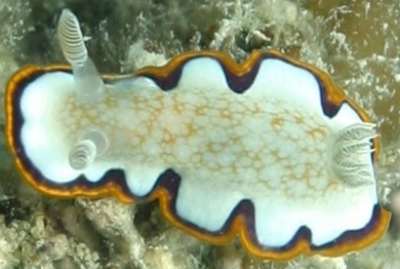
Hi all
Great website very useful. I've come across these beasts many times in Bahrain (Persian Gulf) typically amongst dead coral structrues.
Locality: Bahrain, Persian Gulf. dead coral reef. Depth: 2 m - 5 m. Length: 40 mm. October 2005. Shallow. Photographer: Mike Arora
I would be grateful if somebody could identify this one
Mike
michael@phegulf.com.bh
Arora, M.K., 2005 (Dec 16) Chromodoris obsoleta from Bahrain. [Message in] Sea Slug Forum. Australian Museum, Sydney. Available from http://www.seaslugforum.net/find/15488Dear Mike,
This is Chromodoris obsoleta. As you will see from the other messages, we know very little about this species, and apart from a couple of reports in the literature, all we know about it is on the Forum. So if you have photos of it on sponges - perhaps feeding?, or laying eggs, they would be very welcome.
Best wishes
Bill Rudman
Chromodoris obsoleta - 3 rhinophores
October 25, 2005
From: Adam Skrzypczyk
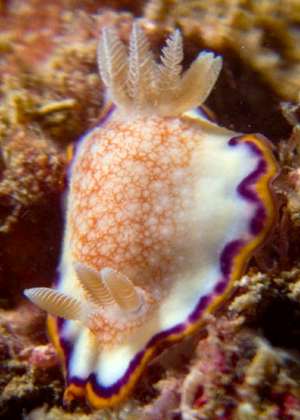
Dear Bill,
I took this image of Chromodoris obsoleta a few days ago (21 October 2005) in the Gulf of Oman. Initially what brought my attnetion to it was the 3 rhinophores. It has been pointed out to me however that this is also a rare species and that i should send the image over to you.
Location Details: Car Cemetery, about half a mile of the coast of Khor
Fakkan, United Arab Emirates, Gulf of Oman (Arabian Sea). 16 metres deep. The specimen was about 1.5 - 2 cm in length. sandy bottom with an artificial reef of old cars. Photo: Adam Skrzypczyk
Regards,
Adam Skrzypczyk.
adamskr@yahoo.com
Skrzypczyk, A., 2005 (Oct 25) Chromodoris obsoleta - 3 rhinophores. [Message in] Sea Slug Forum. Australian Museum, Sydney. Available from http://www.seaslugforum.net/find/15102Dear Adam,
Yes this is a rarely reported species so records of it are always welcome. I'll also add its 3 rhinophores to the Abnormalities List. Any other nudibranch images from the Gulf of Oman would also be of interest as we have little information of the fauna of that region.
Best wishes,
Bill Rudman
Chromodoris obsoleta from the Red Sea
August 5, 2004
From: Tony Reavill
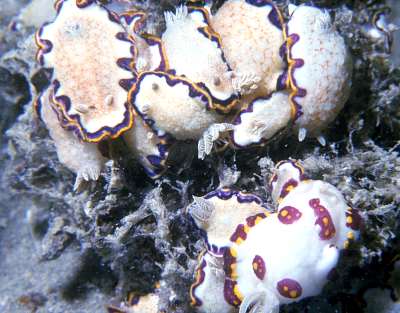
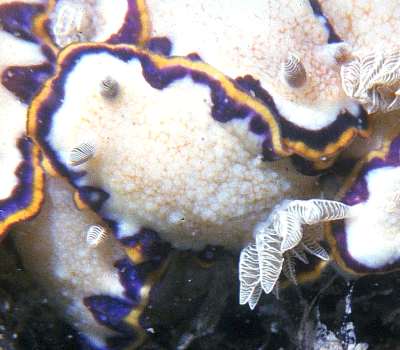
Hi Bill,
Here are some photos of Chromodoris obsoleta to accompany my message on C. cazae [#12730]
Both species were from the same locality, Doha, Qatar, Persian Gulf. The bulk of the pictures were taken 2nd February 1979 in 12 metres of water,
This photo shows a cluster of animals, including on C. cazae on what I guess is a sponge.
Best regards
Tony Reavill
tajreavill@o2.co.uk
Reavill, T., 2004 (Aug 5) Chromodoris obsoleta from the Red Sea. [Message in] Sea Slug Forum. Australian Museum, Sydney. Available from http://www.seaslugforum.net/find/12729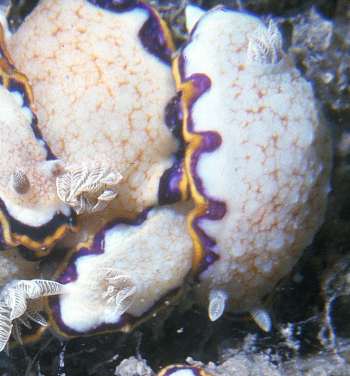
Dear Tony,
Thanks for sending these interesting photos of Chromodoris obsoleta. As I comment in a separate message [#12737] this is quite a rare species, or at least rarely reported. I agree that these animals are almost certainly clusterde on their food sponge. Unfortunately thety are so far through their meal that there is not enough left to identify the sponge. We can say though that both species apparently feed on the same sponge.
If you have any other interesting photos from your time in Qatar they would be very welcome
Best wishes
Bill Rudman
New records of the rare Chromodoris obsoleta
August 5, 2004
From: Bill Rudman
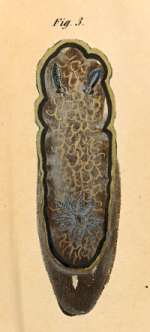
PHOTO: Original figure from Ruppell & Leuckart, 1830: Tab. 9, fig. 3.
Tony Reavill's photos [#12729] of Chromodoris obsoleta are an interesting addition to our knowledge of the species. Originally described from the Red Sea, there are few records of this species. The original account describes it as milky white, with an orange-brown reticulation on the mantle, and a band of orange at the mantle edge, and a submarginal band of blue-black. To that description we can ass that the rhinophores and gills are translucent brown with the edges of the leaflets outlined in opaque white. The mantle colours show through ventrally, and the foot is white. The original illustration available to me suggests a brownish background colour but this does not accord to the written text and is possibly an artistic error or a result of the deterioration of the colour plate in the 170 years since its printing.
Eliot (1911) describes the external colour and radular morphology of specimens from the Red Sea but misidentifies it as a possible form of Chromodoris reticulata Pease [see Rudman, 1973]. Gohar & Soliman (1967) describe the embryology and life history of a species they identify with C. obsoleta but from their color description of the living animal it would seem that their animal species was a species of Glossodoris and not C. obsoleta.
I know of two other records, one from Seghala Is, Red Sea, which Nathalie Yonow sent to me for identification (Yonow, 1989) and a specimen from Suakin, on the Sudanese Red Sea sent to me by Chris Todd, [see separate message #12737]. I have also included photos of its radula [#12734] to show that it is a species of Chromodoris.
References:
• Eliot, C.N.E. (1911) Chromodorids from the Red Sea, collected and figured by Mr. Cyril Crossland. Proceedings of the Zoological Society of London, 2: 1068-1072. (Pl.61)
• Gohar, H.A.F. & Soliman, G.N. (1967) The direct development of the nudibranch Casella obsoleta (Rupp. and Leuck.) (with remarks on the metamorphosis). Publications of the Marine Biological Station, Al-Ghardaqa, Egypt, 14: 149-166.
• Rudman, W.B. (1973) Chromodorid opisthobranch Mollusca from the Indo-West Pacific. Zoological Journal of the Linnean Society, 52(3): 175-199, 7figs, 2col.pl.
• Rüppell, E. & Leuckart, F.S. (1830 or 31) Neue wirbellose Thiere des Rothen Meeres. Atlas zu der Reise im nördlichen Afrika von Eduard Rüppell. Brunner, Frankfurt am Main. 23-50, pls 7-12 pages.
• Yonow, N .(1989) Red Sea Opisthobranchia 2: The family Chromodorididae (Mollusca, Nudibranchia). Fauna of Saudi Arabia 10: 290-309.
Bill Rudman
Rudman, W.B., 2004 (Aug 5) New records of the rare Chromodoris obsoleta. [Message in] Sea Slug Forum. Australian Museum, Sydney. Available from http://www.seaslugforum.net/find/12733Radula of Chromodoris obsoleta
August 5, 2004
From: Bill Rudman
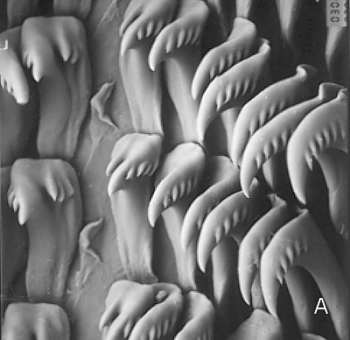
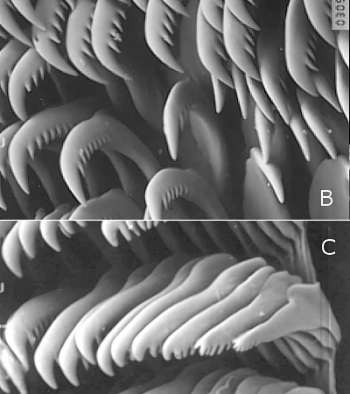
Here are some photos of the radula of the specimen of Chromodoris obsoleta photographed in a separate message [#12737].
Locality: Suakin, Sudan, Red Sea, 25 April 1980, 17mm long alive. AM C131569. PHOTO: Chris Todd.
The morphology of the radular teeth and the jaw rodlets confirm that it is a species of Chromodoris. The radular formula is 48(+3) x 43. 1. 43, with the central tooth reduced to s small triangular plate. Tooth 1 has 2-3 inner denticles at the base of the long pointed cusp which bears 4 or 5 pointed outer denticles. From Tooth 2 the teeth quickly increase in size so by Tooth 6 the cusp is about twice the length of that of Tooth 1. From Tooth 6 to approximately Tooth 35 the teeth are of similar size with up to seven outer denticles. From Tooth 36 the teeth begin to chnage shape and reduce in size, the outermost teeth being flattened traingular blades with 4-5 small terminal denticles. The bicuspid jaw rodlets are typical of the gemus Chromodoris.
Bill Rudman
Rudman, W.B., 2004 (Aug 5) Radula of Chromodoris obsoleta. [Message in] Sea Slug Forum. Australian Museum, Sydney. Available from http://www.seaslugforum.net/find/12734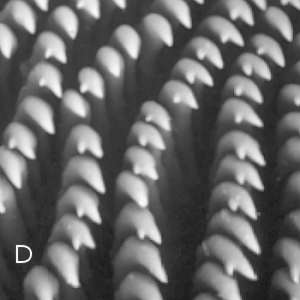
PHOTOS: A, central region showing remnant central tooth, Tooth 1 on each side, and Tooth 2-6 on right side. B, mid-lateral teet on right side. C, outermost teeth on right side. D, jaw rodlets, showing bicuspid tip. SEM Photos: Geoff Avern.
Rudman, W.B., 2004 (Aug 5). Comment on Radula of Chromodoris obsoleta by Bill Rudman. [Message in] Sea Slug Forum. Australian Museum, Sydney. Available from http://www.seaslugforum.net/find/12734Chromodoris obsoleta from Sudan
August 5, 2004
From: Bill Rudman

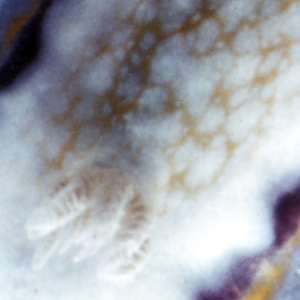
To accompany Tony Reavill's photos of the rarely found Chromodoris obsoleta from [message #12729], here is a record from the Sudanese Red Sea. The specimen was kindly given to me by Dr C.D. Todd who collected during the British Suakin Expedition to the Sudanese Red Sea.
Locality: Suakin, Sudan, Red Sea, 25 April 1980, 17mm long alive. AM C131569. PHOTO: Chris Todd.
The colour is much the same as in Tony Reavill's specimens. I have posted a description of the radula morphology in a separate message [#12734].
Bill Rudman
Rudman, W.B., 2004 (Aug 5) Chromodoris obsoleta from Sudan. [Message in] Sea Slug Forum. Australian Museum, Sydney. Available from http://www.seaslugforum.net/find/12737